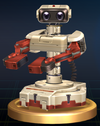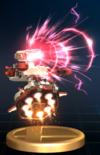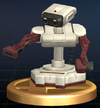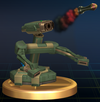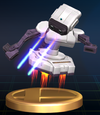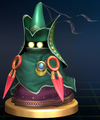R.O.B. (universe)
| R.O.B. (universe) | |
|---|---|
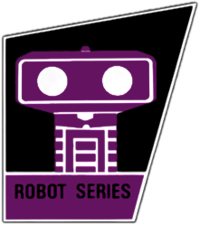 
| |
| Developer(s) | Nintendo |
| Publisher(s) | Nintendo |
| Genre(s) | Puzzle |
| Console/platform of origin | Nintendo Entertainment System |
| First installment | Stack-Up (1985) |
| Latest installment | Gyromite (1985) |
The R.O.B. universe (ロボット, Robot) refers to the usage of the historically significant Robotic Operating Buddy peripheral for the NES as a playable character entity in the Super Smash Bros. series. It was first represented in Super Smash Bros. Brawl, both as a playable character and as a set of enemies in the Subspace Emissary story mode as the R.O.B. Squad. R.O.B. returns as a secret unlockable character in Super Smash Bros. 4.
Franchise description
Roughly around the same time as Nintendo's domestic launch of its new video game console, the Famicom, in July 1983, one of the most infamous and historically significant time periods in the video game industry's early timeline was at its height: the two-years-long North American video game recession that began in 1983 and heralded the catastrophic end of the second generation of video gaming. Several causes for the phenomenon are routinely identified by historical retrospectives: roughly a dozen separate consoles were available for retail by 1982, each with its own library of games and its own funding by almost as many different companies, and several of these companies were hastily started and financed in order to join what seemed to be a booming North American video game market - but were not always in possession of their own necessarily accomplished video game programmers. Furthermore, the hardware manufacturers of this era - in stark contrast to Nintendo, Sega, Sony, and Microsoft in later decades - did not have exclusive control of their platforms' supply of games, effectively meaning that any group could make a game and sell it, and there was nothing to prevent limited shelf space in stores from being overloaded by third-party publishers' material. This effectively resulted in the industry becoming flooded with games of notably low quality that were nonetheless marketed heavily and produced in high numbers.
The two most spectacular such game releases throughout 1982, which are popularly labeled "the games that killed gaming", were an Atari 2600 port of the landmark and popular arcade game Pac-Man and an Atari 2600 game based on the then-highest grossing film of all time, E.T. the Extra-Terrestrial. Both games were high-profile titles that were adaptations of properties that were themselves extremely high-profile, and in both cases, Atari rushed their programming and development processes to make early releases, and manufactured colossal amounts of units in anticipation of huge hits. Both games were universally panned by critics and consumers alike, and while they sold very well in terms of absolute numbers, Atari grossly overestimated the number of sales they would generate, and many unsold units remained in stock at stores. This began a brutal chain reaction across the entire North American market, which was not at all helped by a newly soured consumer outlook on the video game concept: most stores, lacking space to carry new games and consoles, had no choice but to attempt to return surplus games to recent publishers, but since publishers had neither new products to supply nor cash to issue refunds to the retailers, many companies folded, and of those that did not, several abandoned the video game business entirely. Stores left with units that could no longer be returned to defunct publishers could only resort to offering the titles for spectacularly low bargain-bin prices. Toy retailers that controlled consumer access to games had concluded that video games were a fad that had in fact ended, and therefore became opposed to devoting shelf space to video games and consoles in favor of other types of entertainment products.
The massive recession of North America's video game market into near-complete irrelevance had, of course, by definition handed dominance in the home console market to Japan, and Nintendo's Famicom console was free to build up influence in the country and become the dominant console by far. During development of Super Mario Bros., Nintendo sought an eventual late-1985 Western release for the Famicom and its building library as the "NES", but western retailers' long-established bias against video games and video game-playing machines was a formidable barrier to these plans. Nintendo's Research and Development Team therefore hoped to construct hardware compatible with the console that could help present the NES console to these retailers as a "toy" and "entertainment system" with compatible "Game Paks" and different toy-like peripherals, instead of being presented as merely the latest console-with-cartridges product. The NES Zapper light gun and several games associated with it were already on hand to help provide this image, but Nintendo proceeded to develop a mechanically complex, battery-powered peripheral resembling a nearly-foot-tall robot that was literally named "Robot". They developed two NES cartridges compatible with the device: Robot Block, released in Japan along with the Robot unit itself near the end of July 1985, and Robot Gyro, released mid-August. Robot was renamed "R.O.B." for its Western release, and its associated games Stack-Up and Gyromite, respectively.
The Western launch date of the NES, October 18th, 1985, was a month after Super Mario Bros. revolutionized the video game market in Japan. Nintendo's ploy to use R.O.B. to convince American toy retailers to allow the NES video game console in their stores was evidently successful, for Super Mario Bros., the NES, and the rest of its extensive launch library were uninhibited in their distribution and sales in the West. The irony is that, in any other circumstance, R.O.B. and its two games would likely have been remembered as a dismal failure in Nintendo's timeline of experimental peripherals for its game consoles; not only were Gyromite and Stack-up the only two packages ever released for the unit, but videos showing the unit in action demonstrate that R.O.B.'s operative efficiency and practicality with even these two games were questionable at best. Gyromite was effectively a side-scrolling game where the controls were split between player-character movement on Player 1's +Control Pad and environmental effects on Player 2's B and A buttons, making it a cooperative game, and R.O.B.'s contribution to Gyromite was effectively as an optional substitute for a second player, where pressing Start on Player 1's controller would compel R.O.B. to press an appropriate button on the Player 2 controller after going through roughly half a minute's worth of pre-programmed motions. Stack-Up, on the other hand, fared better as software that used the R.O.B. unit itself as a physical game device, where electronically inputting commands with the NES controller would compel R.O.B. to move and drop colored blocks onto stands surrounding its base, though the pre-programmed motions of the R.O.B. unit often knocked blocks off their stands unintentionally.
Nonetheless, analysts argue that the R.O.B. unit had a uniquely profound and important effect in the history of video games as a market, even if it was entirely due to its "trojan horse" concept rather than its actual performance as a product. To what degree R.O.B. truly "allowed" the newly Nintendo-dominated video game business to proliferate in the West is a point of debate, but Nintendo has shown itself to hold the R.O.B. unit in high regard by including various cameo depictions of it in a rather large number of its modern-day franchises. A robot resembling R.O.B. named "NAV-COM" was an important side character in StarTropics; Kirby was able to collect its parts and reassemble them in a puzzle in Kirby's Dream Land 3; a humanoid robot controlling the Great Fox was named "ROB 64" in the Western releases of the Star Fox series; several R.O.B.-centered microgames have been featured throughout the WarioWare series; a model of R.O.B. decorated part of the track Port Town Aero Dive in F-Zero GX (which also appears in Brawl); its head is one of the collectible objective objects in Pikmin 2; R.O.B. was a selectable racer in Mario Kart DS, and one of its karts resembled it dressed up in its Stack-Up accessories; and R.O.B. appeared as a playable fighter in Super Smash Bros. Brawl, where he was given a primary role in the game's Adventure Mode, and in Super Smash Bros. 4. R.O.B. even appeared on the back box art of a third-party GameCube game, Viewtiful Joe by Capcom.
As for the scenario in the two "Robot Series" games themselves, they both featured an onscreen player-character named Professor Hector, who in Stack-Up simply existed to be controlled into hopping across a keyboard-like graphic onscreen in order to dictate the physical R.O.B. unit's carry-and-drop movements of the colored blocks around it. Sometimes, enemies referred to as "glitches" named Spike & Flipper got in his way. In Gyromite, a more detailed scenario was provided: Professor Hector has been trapped in rooms filled with dynamite and hostile enemies named Smicks, and he is otherwise defenseless in his quest to grab all the dynamite in each stage, except for the presence of colored pedestals scattered throughout each stage that may be raised or lowered by the button presses of the second player's controller. These pedestals may trap Smicks out of the professor's way and may even squish them - or Hector himself if he is not careful - and the R.O.B. unit that may be used as the second player, which essentially drops spinning tops called "gyros" onto the second NES controller's red buttons to keep the gates held down for the player operating the first NES controller - represents Hector's creation helping him out of his predicament.
In Super Smash Bros. Brawl
Since the R.O.B. universe is new to the Super Smash Bros. series and only has two games to draw material from, the universe doesn't have that much representation, with just one character, enemy, item (R.O.B's down special move, Gyro) and a music track, with no stages representing his "universe". It is likely due to the fact that R.O.B is a playable accessory that he doesn't have a stage for his universe. Mario Bros. is R.O.B.'s home stage in the Classic and All-Star Modes.
Characters
- R.O.B.: R.O.B. is the only playable character in the R.O.B. universe. His moveset is unique to Brawl with a few references to the Robotic Operating Buddy accessory; for example, the flashing red light on R.O.B.'s head when his Robo Beam is charged is a throwback to when the red light flashed to indicate that R.O.B. was ready for use with the NES.
On the final character select screen (after all characters are unlocked), R.O.B. shares the fourth column with fellow Famicom/NES-originated characters Ice Climbers, Pit and Samus.
Trophies
Trophies which feature R.O.B.s are:
R.O.B. (Series: "Others". Unlock: Clear Classic Mode as R.O.B.)
R.O.B. sporting his Famicom colors. R.O.B. debuted in Japan as Robot in 1985 as an add-on for the Famicom. He could be combined with a "gyro set," etc. for two types of play. The player controlled Professor Hector, the TV emitted light, and R.O.B. responded to the light by moving. At the time, it was epoch-making game play. Recently, R.O.B. appeared in Mario Kart DS.
: Nintendo Entertainment System Robotic Operating Buddy
Diffusion Beam (Series: "Others". Unlock: Clear All-Star Mode as R.O.B.)
R.O.B.'s Final Smash. He emits a beam from his eyes that spreads across the spectrum and undulates in great variety as it travels. What makes this technique different is R.O.B.'s ability to move while using it. This allows him to use it in combination with his other moves to increase his Final Smash's effectiveness.
R.O.B. Sentry (Use Trophy Stand)
A robot with a two-armed shot. This R.O.B. uses the booster on its base to propel its jumps. Often used in the Subspace Army bomb factory in defense or labor roles, the R.O.B. Sentry also works as a detonator. Its emotional capacity is unknown, but it has utter trust in the Ancient Minister and obeys him unwaveringly. This production model has been made in great numbers.
R.O.B. Launcher (Series: The Subspace Emissary. Unlock: Use Trophy Stand)
An upgraded R.O.B. model with a missile-launcher head that bolsters firepower. The standard coloring has also been refinished with a green and brown military motif, stylishly accented with a blue cord connecting the arm sections and base. This R.O.B. does not use its arms—attacks are limited to the missiles fired from its head.
R.O.B. Blaster (Series: The Subspace Emissary. Unlock:Use Trophy Stand)
A R.O.B. model boasting robo-beam- blasting eye lenses suited for long-range combat. There are two types—one acts like a stationary gun, sitting in place and lining up targets, and the other is mobile. Actually, the R.O.B. Sentry also features beam-firing capabilities, but because the roles of the R.O.B. Squad are so well defined, there's no conflict between the ranks.
Ancient Minister (Series: The Subspace Emissary. Unlock: Adventure Mode: The Subspace Emissary)
The commander of the Subspace Army who uses Subspace Bombs to tear up this world. He was once the lord of this world, living on the floating Island of the Ancients with many robots-but the robots were taken hostage on Tabuu's orders. Now that their home's a bomb factory, the robots carry out their functions while enduring deep sadness caused by the loss of their colleagues.
Subspace Bomb (Series: The Subspace Emissary. Unlock: Clear Boss Battles on Easy difficulty)
A weapon that, when it explodes, draws every part of this world within its blast range into Subspace. The areas drawn into Subspace this way float about in bubbles as individual colonies. To detonate a bomb, two R.O.B.'s must be destroyed in the process. The Ancient Minister is bitterly aggrieved by this fact.
Music
- Gyromite - A remix of the title theme of Stack-up, the game R.O.B. was packaged with and it was mislabeled as being the background music from Gyromite in SSBB, though there are some short tracks from Gyromite thrown into the mix. It is used on the Mario Bros. stage. This track is also played during R.O.B.'s Character Roll Call.
- R.O.B.'s victory theme - Upbeat music derived from Stack-Up background music when it was R.O.B.'s victory
Stickers
| Name | Game | Effect | Characters |
|---|---|---|---|
| R.O.B. | Mario Kart DS | [Specials: Indirect] Attack +15 | R.O.B. |
| Robot & Blocks | Stack-Up | [Specials: Indirect] Attack +27 | R.O.B. |
| Robot | Mario Kart DS | [Energy] Attack +32 | R.O.B. |
In Super Smash Bros. 4
The R.O.B. series returns in SSB4. However, its representation is very odd: Only 1 character represented in both versions, 1 veteran music track returning only in the Wii U version, and that's it, making this universe more of a "Bonus" universe, just like the Earthbound and F-Zero universes in SSB and the Fire Emblem universe in SSBM.
Characters
- R.O.B.: R.O.B. returns from Brawl. His moveset is, in effect, largely unchanged. He does have new animations for many of his attacks though, and several buffs damage-wise. He also has a new Final Smash and his default costume changes between versions, similar to his Mario Kart DS appearance.
Music
- Stack-Up / Gyromite: Returns unchanged from Brawl. It is used on the Wrecking Crew stage.
Games with influences
Gyromite
This game was the first with the inclusion of the Robotic Operating Buddy, also known as Robot in Japan and R.O.B. in the Americas. Gyro was based on a top-like accessory used for the game. Also, a remix of the music from this game is used in Super Smash Bros. Brawl.
Trivia
- The R.O.B. universe is the only universe with a playable character to lack a stage for more than one Smash game and by extension the only universe to have a playable character but never a stage.
- In Brawl, R.O.B boasts the Famicom color scheme of red and white as his default color scheme. However, in Super Smash Bros. for Nintendo 3DS and Super Smash Bros. for Wii U, his default color scheme is grey and white for non-Japanese copies of these games to reference his appearance for PAL and American NES consoles.
- The R.O.B. universe is one of the only non-third party universes with a playable character introduced after Melee to not have been represented in any way in previous Smash games before its Smash debut. The others being Wii Fit and Xenoblade Chronicles.
|
| |
|---|---|
| Fighter | R.O.B. (SSBB · SSB4 · SSBU) |
| Enemies | R.O.B. Squad (R.O.B. Blaster · R.O.B. Launcher · R.O.B. Sentry) |
| Other | Ancient Minister · Isle of the Ancients |
| Trophies, Stickers, and Spirits | Trophies (SSBB · SSB4) · Spirits |
| Music | Gyromite |
